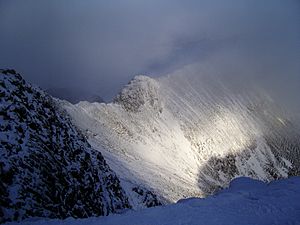Charles Gough (artist) facts for kids
Quick facts for kids
Charles Gough
|
|
|---|---|
| Born | 1784 |
| Died | April 1805 |
Charles Gough (born 1784 – died April 1805) was an artist from the late 1700s and early 1800s. He was part of the early English Romantic movement. This was a time when artists and writers focused on strong emotions, nature, and imagination. Charles Gough was not famous during his life. However, after his mysterious death in 1805, his story became well-known. It inspired many famous poets and artists of that time.
Charles Gough's Mysterious Death
In April 1805, Charles Gough was visiting the Lake District in England. He was a tourist from Manchester. On April 17, he decided to hike over Helvellyn mountain to Grasmere. He took his dog, Foxie, with him. They started their climb on a difficult path called Striding Edge. Charles Gough was never seen alive again after that day.
Three months later, on July 27, a shepherd heard a dog barking. The sound came from near Red Tarn, a lake on the mountain. The shepherd went to investigate. He found Foxie next to her master's body. The shepherd called for help. A group of people came back to the scene. They found Gough's remains and some of his things. These included fishing gear, a gold watch, and a silver pencil. His hat was also found, split in two. This suggested he had fallen from Striding Edge.
Foxie had survived for months next to her dead owner. She had even given birth to a puppy. Sadly, the puppy died soon after it was born.
People wondered how Charles Gough had died. They also wondered why he tried to climb Helvellyn without a guide. Gough was known for taking risks. A man named Thomas Clarkson had met him. Clarkson said Gough was a "venturesome person." His stubborn nature worried the local shepherds. Gough was supposed to have a guide. But the guide was busy that day with the local army group. Charles Gough was later buried in a Quaker graveyard. This graveyard is in Tirril, near Penrith, Cumbria.
How Charles Gough Inspired Others
The story of Charles Gough's death touched many people. He died while exploring nature, and his loyal dog stayed by his side. This inspired both poets and artists. They saw him as a symbol of the Romantic ideal. Their works showed the strong connection between humans and nature. Foxie, the faithful dog, represented this bond. The wild mountain landscape that caused Gough's death showed nature's power.
Two famous artists painted the scene. These were Francis Danby and Edwin Landseer. Landseer's painting was called Attachment. It was shown at the Royal Academy in 1830. A poem called Helvellyn went with the painting. Sir Walter Scott wrote this poem about Gough's death. William Wordsworth also wrote a poem about the scene. It was called Fidelity. Wordsworth lived in the Lake District. He even took Scott and the scientist Humphry Davy to see the exact spot where Gough's body was found.
Today, Charles Gough's story is still remembered. A book called The Unfortunate Tourist of Helvellyn by Simon Morley explores his death. There is even an ale brewed by the Tirril Brewery called 'Charles Gough's Old Faithful'.


